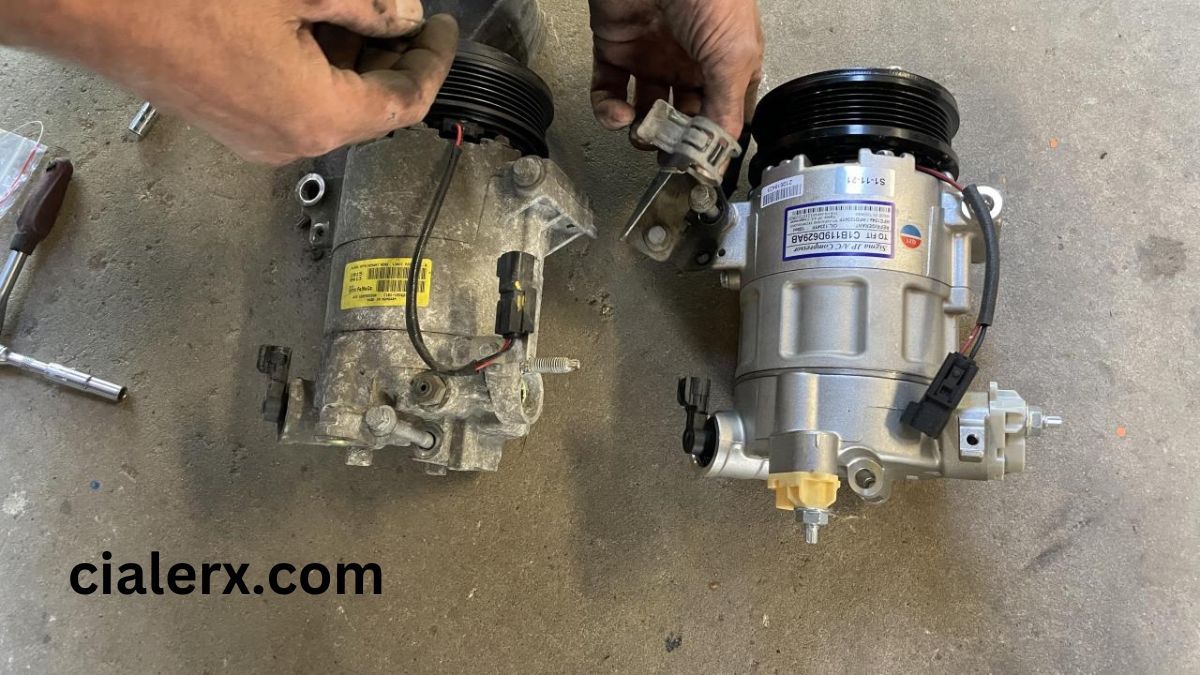TECH
The Risks of Disconnecting Your AC Compressor: A Comprehensive Guide

When the heat of summer hits, your air conditioning system becomes a lifeline. At the heart of this crucial appliance lies the AC compressor, working tirelessly to keep your home cool and comfortable. But what happens when you consider disconnecting it? While there might be various reasons for wanting to bypass this essential component, it’s vital to understand the potential consequences before making that decision. In this comprehensive guide, we’ll explore everything from the fundamental role of your AC compressor to the risks associated with disconnecting it and how you can maintain its efficiency instead. Whether you’re a DIY enthusiast or simply looking to learn more about your cooling system, there’s valuable information ahead!
The Importance of Your AC Compressor
The AC compressor is the heart of your air conditioning system. It plays a vital role in circulating refrigerant throughout the entire unit.
When you set your thermostat, the compressor kicks into action. It compresses low-pressure gas and transforms it into high-pressure gas, allowing heat exchange to occur.
This process cools down the air that circulates through your home, providing comfort during those hot summer days. Without a functioning compressor, even the best AC units can’t deliver relief from rising temperatures.
Beyond comfort, an operational compressor ensures energy efficiency too. A well-maintained system can help lower utility bills while maintaining optimal performance.
Ignoring its importance could lead to costly repairs or replacements down the line. Proper attention to this critical component can extend its lifespan and keep your indoor environment pleasant year-round.
Common Reasons for Disconnecting an AC Compressor
There are several reasons why a homeowner might consider disconnecting their AC compressor. One common reason is to perform necessary repairs or maintenance. Sometimes, routine checks can’t be completed without temporarily disabling the unit.
Another reason could be energy savings during off-seasons. Many people choose to disconnect their compressor when temperatures drop, believing it will reduce wear and tear.
In some cases, users may experience unusual noises or performance issues that prompt them to cut power as a troubleshooting step. This can be an attempt to pinpoint the source of the problem.
There’s the occasional decision tied to relocating or upgrading HVAC systems. When replacing older models with more efficient ones, disconnecting becomes part of the installation process. Each situation has its unique considerations and potential implications for system health and efficiency.
Risks Associated with Disconnecting an AC Compressor
Disconnecting your AC compressor might seem like a quick fix. However, this action carries significant risks that can lead to costly repairs.
Disconnecting the compressor can cause refrigerant leaks. This not only harms the environment but also diminishes your system’s efficiency when you reconnect it.
Electrical issues are another concern. Without proper precautions, you could expose wires or components to damage during disconnection. This could result in safety hazards such as short circuits or fires.
Additionally, if reconnected improperly, the entire HVAC system may malfunction. You could face poor cooling performance and increased energy bills due to an inefficient setup.
Alternatives to Disconnecting Your AC Compressor
If you’re considering disconnecting your AC compressor due to issues or inefficiencies, there are better alternatives worth exploring. First, consider a professional inspection. A qualified technician can diagnose problems and recommend repairs that may save your unit.
Another option is regular maintenance. Simple tasks like cleaning filters and coils can significantly improve performance without the need for disconnection. By keeping your system clean, you enhance airflow and efficiency.
You might also think about upgrading components rather than fully disconnecting them. Newer parts often come with improved technology that enhances cooling while reducing energy consumption.
If you’re facing persistent issues, installing a secondary cooling solution could be beneficial. Portable air conditioners or fans provide relief without compromising the functionality of your existing AC system.
Properly Maintaining Your AC Compressor
Regular maintenance is vital for the longevity of your AC compressor. Start by checking the air filters monthly. Clogged filters can restrict airflow, making your system work harder than necessary.
Cleaning the condenser coils is another important task. Dust and debris accumulate over time, reducing efficiency. A gentle rinse with a garden hose can often do wonders.
Don’t forget to inspect the refrigerant levels. Low refrigerant can lead to increased pressure on the compressor, causing potential damage.
Also, listen for unusual noises when your unit operates. Strange sounds could indicate underlying issues that need immediate attention.
Consider scheduling annual professional maintenance checks. Technicians can identify problems early on and ensure everything runs smoothly throughout hot seasons.
Conclusion
Understanding the complexities of an AC compressor is essential for any homeowner. It’s not just another component; it plays a pivotal role in maintaining indoor comfort.
Choosing to disconnect your AC compressor can lead to unexpected challenges. The risks often outweigh the benefits, impacting both performance and longevity.
Prioritizing maintenance can make a significant difference in efficiency. Regular check-ups ensure that everything runs smoothly, reducing the urge to disconnect.
Consider exploring alternatives if you’re facing issues with your unit. Professional help or minor repairs could save you from unnecessary complications down the line.
Taking care of your AC compressor means you’ll enjoy cool air when it matters most. A little diligence goes a long way in prolonging its lifespan and enhancing energy efficiency.
FAQs
An AC compressor is a critical component of your air conditioning system. It helps circulate refrigerant, which absorbs heat from the indoor air and releases it outside, keeping your space cool.
Why might someone disconnect their AC compressor?
People often consider disconnecting their AC compressors due to issues like noise, perceived energy savings, or during maintenance. However, these reasons can lead to more significant problems down the road.
Can I operate my AC unit without a functioning compressor?
Operating an AC unit without a functioning compressor is not advisable. The system relies heavily on this component for cooling efficiency. Running it in such conditions can cause further damage and increase repair costs.
How do I maintain my AC compressor effectively?
Regular maintenance includes cleaning the filters and coils, checking refrigerant levels, and scheduling professional inspections at least once a year. Keeping up with these practices will enhance performance and longevity.
What should I do if I’m experiencing issues with my AC compressor?
If you’re facing problems with your AC compressor, it’s best to consult with a professional HVAC technician. They can diagnose the issue accurately and recommend appropriate solutions tailored to your specific needs.
TECH
Why Yell51x-Ouz4 is a Game Changer for Developers

In the ever-evolving world of software development, staying ahead of the curve is essential. Enter Yell51x-Ouz4—a tool that promises to revolutionize how developers tackle their projects. Imagine a powerful system designed not just to meet current demands but to anticipate future needs. With its innovative features and user-friendly interface, Yell51x-Ouz4 is turning heads and capturing attention within the developer community.
This isn’t just another coding platform; it’s a game changer that streamlines processes and enhances creativity. Whether you’re a seasoned pro or just starting out, this tool has something for everyone. Let’s dive deeper into what makes Yell51x-Ouz4 an indispensable asset for developers looking to elevate their work to new heights.
The Benefits of Using Yell51x-Ouz4 for Developers
Yell51x-Ouz4 is revolutionizing the way developers approach their projects. One of its standout features is its intuitive interface, which simplifies complex coding processes. This allows developers to focus on creativity rather than getting lost in intricate details.
Another significant benefit is enhanced collaboration tools. It fosters seamless communication among team members, ensuring everyone stays aligned and informed throughout the development cycle.
Performance optimization is also a key advantage. Yell51x-Ouz4 streamlines code execution, reducing loading times and improving overall application performance.
Additionally, it offers extensive library support for various programming languages, meaning developers can work with familiar frameworks without having to learn new ones from scratch.
This flexibility encourages experimentation and innovation while minimizing friction in the workflow. With these advantages combined, Yell51x-Ouz4 stands out as an essential resource for modern-day developers looking to elevate their skills and output.
How Yell51x-Ouz4 Improves Efficiency and Productivity
Yell51x-Ouz4 is revolutionizing the way developers work. Its intuitive interface allows for seamless navigation, minimizing time spent on mundane tasks.
With its smart automation features, repetitive coding chores are handled effortlessly. This means less time debugging and more focus on creativity and innovation.
Collaboration tools built into Yell51x-Ouz4 foster teamwork among developers. Real-time updates ensure everyone stays in sync, enhancing project flow significantly.
Moreover, integrated analytics provide insights into code performance. Developers can pinpoint issues quickly without sifting through endless lines of code.
By streamlining processes and reducing friction points, Yell51x-Ouz4 enables teams to meet tight deadlines with ease. The result? Increased output without sacrificing quality or burnout rates.
Real-Life Examples and Success Stories of Developers Using Yell51x-Ouz4
Many developers have already embraced Yell51x-Ouz4, showcasing its transformative impact on their projects. One software engineer reported that integrating Yell51x-Ouz4 into his workflow cut down debugging time by nearly 40%. This drastic improvement allowed him to focus more on innovation rather than troubleshooting.
In another case, a small startup utilized the tool for rapid prototyping. Their team was able to launch a beta version in record time, thanks to the streamlined processes facilitated by Yell51x-Ouz4. Feedback from users came quickly, enabling further iterations and enhancements.
A freelance developer shared how using Yell51x-Ouz4 enabled her to take on multiple clients simultaneously without sacrificing quality or deadline commitments. The collaborative features of this tool made project management much smoother and less stressful.
These stories highlight just a few ways that real-world developers are leveraging Yell51x-Ouz4 as an essential asset in their toolkit.
Comparison with Other Development Tools
When comparing Yell51x-Ouz4 with other development tools, the differences become immediately apparent. Many traditional platforms focus on basic functionality, often creating a tedious user experience.
Yell51x-Ouz4 breaks this mold by prioritizing an intuitive interface that enhances usability. Developers can navigate its features seamlessly without extensive training.
Additionally, while many tools require multiple integrations for added functionalities, Yell51x-Ouz4 offers comprehensive solutions within one platform. This reduces the complexity and saves precious time.
Performance is another key area where Yell51x-Ouz4 shines. Its speed and responsiveness outpace options like A123-DevTool or ZetaBuilder, which often struggle under heavy workloads.
Moreover, collaboration capabilities are enhanced in Yell51x-Ouz4 through real-time updates and feedback loops—something many competitors lack. These factors combined make it clear why more developers are making the switch to this innovative tool.
The Future of Yell51x-Ouz4
The future of Yell51x-Ouz4 looks promising as it continues to evolve with technology. Developers are always on the lookout for tools that keep pace with their needs. Yell51x-Ouz4 is positioning itself as a key player in this dynamic landscape.
With advancements in artificial intelligence and machine learning, we can expect even smarter features. These capabilities could streamline workflows further and optimize code quality effortlessly.
Moreover, community-driven improvements will likely shape its development path. Feedback from users enhances functionality and user experience over time.
Integrations with other popular platforms might also expand its reach, making it indispensable for developers everywhere. As trends shift toward remote work environments, tools like Yell51x-Ouz4 will be crucial for teams looking to maintain productivity across distances.
Adoption rates will surely increase as more developers discover its potential to revolutionize their processes. The excitement around this tool indicates it’s here to stay and thrive.
Conclusion: Why Every Developer Should Try Yell51x-Ouz4
Embracing innovation is vital for any developer. Yell51x-Ouz4 stands out as a powerful tool that transforms the development landscape. Its user-friendly interface and robust features cater to both seasoned professionals and newcomers.
Many developers find that integrating Yell51x-Ouz4 into their workflow not only enhances productivity but also sparks creativity. The platform encourages experimentation, allowing users to explore new solutions with ease.
The community surrounding Yell51x-Ouz4 is thriving, offering support and shared insights. This collaborative environment fosters growth and continuous learning.
By leveraging its capabilities, developers can streamline processes and improve project outcomes significantly. Trying Yell51x-Ouz4 could be the catalyst needed for your next big breakthrough in software development.
FAQs
When it comes to development tools, Yell51x-Ouz4 stands out as a remarkable innovation that can reshape the way developers approach their work. By embracing this tool, developers are sure to experience enhanced efficiency and productivity.
Now let’s address some frequently asked questions about Yell51x-Ouz4:
What is Yell51x-Ouz4?
Yell51x-Ouz4 is an advanced development platform designed specifically for software engineers looking to streamline their workflow and improve coding practices.
How does Yell51x-Ouz4 differ from other tools?
Unlike traditional development environments, Yell51x-Ouz4 integrates various functionalities into one streamlined interface, making it easier for developers to manage projects efficiently.
What programming languages does it support?
Yell51x-Ouz4 supports multiple programming languages including JavaScript, Python, Ruby, and more. This versatility allows developers from different backgrounds to utilize its features effectively.
Is there a learning curve associated with using Yell51x-Ouz4?
While there’s always a period of adjustment when adopting new technology, many users report that the user-friendly design of Yell51x-Ouz4 makes it intuitive and easy to navigate.
Can beginners benefit from using this tool?
Absolutely! Beginners can find valuable resources within the platform that help them learn while they code. It serves not just seasoned professionals but also those starting in tech.
Are there any costs associated with using Yell51x-Ouz4?
Yell51x-Ouz4 offers various pricing models catering to individual needs—ranging from free trials for newcomers all the way up to premium plans for larger teams or enterprises.
The potential impact of integrating tools like Yell51x-Ouz4 into your toolkit could be significant. Don’t miss out on what might become your most valuable resource yet!
TECH
The Rise of Mini Electric Chopper Bikes: A New Wave in Urban Mobility

Urban streets are buzzing with a new trend that promises to revolutionize how we navigate our cities. Enter the world of mini electric chopper bikes—sleek, compact machines designed for modern mobility. These stylish rides aren’t just about looking good; they offer a practical solution to everyday commuting challenges. As city dwellers seek alternatives to traditional transportation methods, mini electric chopper bikes have emerged as an exciting choice for both convenience and fun.
Imagine zipping through traffic effortlessly, bypassing congestion while enjoying the fresh air on your face. With their unique design and eco-friendly features, these bikes cater to those who value efficiency without sacrificing style. Whether you’re heading to work or exploring your neighborhood, mini electric chopper bikes provide a compelling way to get around in today’s fast-paced urban environments. Let’s dive into what makes them so appealing and why they might just be the future of city commuting!
Benefits of Using a Mini Electric Chopper Bike
Mini electric chopper bikes offer a blend of style and efficiency. Their compact design makes them perfect for navigating through crowded urban areas.
One significant benefit is their eco-friendliness. With zero emissions, they contribute to cleaner air in cities. This makes them an excellent choice for Environmentally friendly conscious riders.
Cost savings are another perk. Mini electric chopper bikes have lower operating costs compared to traditional vehicles. You save on fuel, parking fees, and maintenance expenses.
Riding one can also boost your mood! The thrill of cruising around town on a stylish bike brings joy and freedom that’s hard to match.
These bikes promote health by encouraging outdoor activity without the physical strain of pedaling long distances. Whether commuting or exploring, you enjoy the best of both worlds—fun and practicality.
Comparison with Traditional Modes of Transportation
Mini electric chopper bikes are changing the game in urban mobility. Unlike cars, they occupy minimal space and can weave through traffic easily. This agility helps riders save time on their daily commutes.
When comparing costs, mini electric choppers stand out. They require less maintenance than traditional vehicles and cost significantly less to charge compared to fueling a car. It’s an economical choice for many city dwellers.
Public transport often comes with delays and waiting times. Mini electric chopper bikes offer freedom from schedules, letting users travel at their own pace.
Additionally, these bikes contribute to reducing carbon footprints. With zero emissions during operation, they promote cleaner air in bustling cities where pollution is a concern.
Comfort is also worth mentioning; riding a mini electric chopper can be more enjoyable than jostling on crowded buses or trains while stuck in rush hour traffic.
Popular Brands and Models in the Market
The market for mini electric chopper bikes has exploded with exciting options. Brands like Juiced Bikes and Rambo Bikes have made a name for themselves, combining style with performance.
Juiced Bikes offers models such as the HyperScrambler 2, known for its robust build and impressive range. Riders appreciate its unique design that stands out in urban settings.
Rambo Bikes focuses on adventure-ready options. Their R750 model features rugged tires and powerful motors, perfect for those who crave off-road experiences while maintaining city mobility.
Another notable mention is Super73. This brand captures attention with its retro aesthetics and customizable features, appealing to a younger audience eager to express individuality through their rides.
Each of these brands brings something different to the table, ensuring riders find the perfect mini electric chopper bike tailored to their needs.
How to Choose the Right Mini Electric Chopper Bike for You
Choosing the right mini electric chopper bike can feel overwhelming, but it doesn’t have to be.
Start by assessing your riding needs. Consider how often you’ll use it and for what purpose—commuting, leisure rides, or errands. Your primary reason will guide many of your decisions.
Next, think about battery life. Longer ranges are ideal if you plan on longer journeys without frequent charging opportunities.
Weight and size matter too. A lighter model is easier to handle and store while still being powerful enough for urban environments.
Don’t forget comfort features like adjustable seats and handlebars. You want a bike that feels good on every ride.
Research brand reputation and customer reviews before making a decision. This information can provide insight into performance and reliability over time.
Tips for Safe Riding and Maintenance
Riding a mini electric chopper bike offers freedom and fun, but safety should always come first. Always wear a helmet to protect yourself from potential injuries. It’s also wise to don reflective gear or bright clothing for visibility, especially in low-light conditions.
Before hitting the road, inspect your bike regularly. Check tire pressure, brakes, and lights to ensure everything is functioning correctly. A quick pre-ride checklist can save you from unexpected issues later on.
When riding in traffic, keep an eye out for pedestrians and other vehicles. Stay aware of your surroundings at all times; distractions can lead to accidents.
For maintenance, clean your bike after use to remove dirt and grime that may affect performance. Regularly lubricate the chain for smooth operation. Following these tips will help you enjoy every ride safely while keeping your mini electric chopper bike in top condition.
The Future of Urban Mobility: Impact of Mini Electric Chopper Bikes
Mini electric chopper bikes are transforming urban landscapes. They offer a nimble, eco-friendly alternative to conventional vehicles. With their compact size and minimal footprint, they can navigate congested streets effortlessly.
Cities are adapting to this shift by incorporating dedicated bike lanes and charging stations. This infrastructure encourages more people to embrace these stylish rides for daily commutes or leisurely outings.
Moreover, as technology advances, we can expect improvements in battery life and performance. Enhanced safety features will also make these bikes even more appealing to newcomers.
The cultural impact is notable too; mini electric chopper bikes promote a sense of community among riders. Shared experiences on the road foster social connections that enrich city life.
As urban areas grapple with pollution and congestion, these innovative machines could play a pivotal role in creating cleaner environments. The rise of mini electric chopper bikes signals change—a step towards sustainable transportation solutions for everyone.
Conclusion
The rise of mini electric chopper bikes is reshaping how we navigate our cities. Their compact size and sleek design make them appealing for urban explorers looking to avoid traffic jams.
As more riders embrace this trend, the benefits become increasingly clear. Eco-friendliness, cost-effectiveness, and ease of use are just a few reasons why these bikes have captured attention.
With numerous brands entering the market, options abound for those ready to join the movement. The promise of an exciting ride lies in every model available today.
Riding responsibly ensures not only your safety but enhances the experience as well. Maintenance tips can keep your bike running smoothly while prolonging its life.
This wave of innovation suggests that urban mobility will continue evolving with each passing year. Embracing new methods like mini electric chopper bikes opens up possibilities for a greener future on our streets.
FAQs
FAQs
What are mini electric chopper bikes?
Mini electric chopper bikes are compact, stylish two-wheeled vehicles powered by electricity. They combine the aesthetics of traditional chopper motorcycles with modern electric mobility features.
How fast can a mini electric chopper bike go?
Most mini electric chopper bikes have top speeds ranging from 20 to 30 mph, making them suitable for urban commuting while remaining safe and manageable.
Are mini electric chopper bikes eco-friendly?
Yes, they produce zero emissions during operation and contribute to reducing air pollution in urban areas. Using renewable energy sources further enhances their eco-friendliness.
Do I need a license to ride a mini electric chopper bike?
Requirements vary by location. Some places may require a motorcycle license or registration, while others treat them like bicycles. Always check local regulations before riding.
What kind of maintenance do these bikes require?
Regular checks on brakes, tires, battery health, and electrical components help ensure optimal performance. Keeping your bike clean also prolongs its lifespan.
Can I take my mini electric chopper bike in public transportation?
This largely depends on the policies of individual transport systems. Many buses or trains allow folding e-bikes but confirm specifics with your local transportation authority beforehand.
Are there any weight limits for riders on these bikes?
Weight limits differ among models but typically range between 200-300 lbs (90-136 kg). Check manufacturer specifications for precise limitations based on the model you choose.
With so many options available in terms of style and functionality, it’s easy to see why mini electric chopper bikes are becoming an attractive choice for those looking to navigate urban landscapes efficiently and enjoyably.
TECH
Building Resilience: Essential Features of Disaster Proof Homes

Natural disasters are becoming more frequent and severe, leaving families vulnerable and homes in ruins. The urgency to protect ourselves from these unpredictable forces has never been greater. Enter disaster proof homes—structures designed with resilience in mind, capable of withstanding the harshest elements mother nature can throw our way.
Imagine a home that not only shelters you but also stands strong against floods, hurricanes, earthquakes, and wildfires. Building such a sanctuary requires knowledge and foresight. It’s about understanding what makes a home resilient and taking actionable steps to fortify it against potential threats.
In this blog post, we’ll explore the essential features that define disaster proof homes. We’ll look at how location matters just as much as building materials and technology for keeping your loved ones safe. Whether you’re constructing a new home or reinforcing an existing one, you’ll find valuable insights here to help you create a haven that endures even the toughest challenges life throws your way. Let’s delve into this vital topic together!
The Impact of Natural Disasters
Natural disasters have profound effects on communities and individuals. They can strike suddenly, leaving devastation in their wake. Homes are destroyed, lives disrupted, and the psychological toll is immense.
People often face loss of property and displacement. The aftermath can lead to long-term emotional trauma that lingers for years. Recovery becomes a daunting journey filled with uncertainty.
Economically, natural disasters drain local resources. Business closures and job losses add to the challenges faced by affected areas. Rebuilding efforts require significant investment and time.
Infrastructure takes a hit as well—roads may be damaged or rendered impassable, disrupting daily life. Essential services like water supply and electricity can falter during these crises.
Communities come together in adversity but also face the stark reality of vulnerability. Preparedness becomes essential not just for survival but for resilience against future calamities that could strike again at any moment.
Essential Features of a Disaster Proof Home
A disaster-proof home is designed with specific features that enhance safety and resilience. One key element is a solid foundation, elevated to withstand flooding. This can include pilings or flood-resistant materials.
Roof design plays a crucial role as well. A sloped roof helps shed wind and rain, reducing the risk of damage during storms. Additionally, impact-resistant windows protect against flying debris while allowing natural light in.
Another essential feature is reinforced doors that can resist strong winds and intruders alike. Adding storm shutters provides an extra layer of protection for vulnerable areas of your home.
Interior designs should prioritize flexible layouts that allow for quick evacuation if needed. Open spaces facilitate easy movement during emergencies, ensuring everyone knows their escape route.
Incorporating sustainable energy sources like solar panels not only reduces reliance on external power but also ensures continuity during disasters when traditional systems might fail.
Choosing the Right Location
Choosing the right location is crucial for building disaster proof homes. Proximity to natural hazards like flood zones, fault lines, or wildland areas can significantly impact safety.
Research local climate patterns and historical data on disasters. Areas prone to hurricanes or tornadoes may require additional precautions.
Evaluate the elevation of your chosen site. Higher ground often reduces flood risks, while avoiding steep slopes minimizes landslide potential.
Local infrastructure also plays a role in resilience. Access to emergency services and community preparedness programs can bolster safety during crises.
Furthermore, consider how nearby vegetation affects fire risk. Homes surrounded by dry brush may need more fire-resistant features compared to those nestled in green landscapes.
Investing time in selecting the right spot lays the foundation for a secure future against nature’s unpredictability.
Building Materials for Disaster Resistance
Choosing the right building materials is crucial for creating disaster-proof homes. Resilient materials can withstand extreme weather and natural calamities, offering peace of mind to homeowners.
Concrete is a top choice due to its strength and durability. It resists fire, wind, and water damage effectively. Reinforced concrete structures are particularly resilient against earthquakes.
Steel framing provides another robust option. Its flexibility allows it to absorb shock better than traditional wood frames during seismic events or high winds.
For flood-prone areas, consider using waterproof materials such as fiber-reinforced polymer or specially treated wood that inhibits rot. These options help keep your home dry during heavy rains or rising waters.
Additionally, impact-resistant windows protect against flying debris in storms while enhancing energy efficiency. By selecting these innovative materials, you significantly increase your home’s resilience against disasters.
Incorporating Technology for Added Protection
Integrating technology into disaster proof homes enhances safety and resilience. Smart home systems can monitor environmental changes in real time, alerting residents to potential threats like floods or high winds.
Automated shut-off valves for gas lines prevent leaks during earthquakes. These features ensure that homeowners can respond swiftly to emergencies.
Surveillance cameras and motion sensors provide security against both human and natural intruders. They help keep an eye on property while you’re away, adding another layer of peace of mind.
Solar-powered backup generators are invaluable during power outages caused by storms. This ensures continuous energy supply for essential appliances, maintaining comfort and safety.
Moreover, apps designed specifically for emergency preparation can guide families through checklists or provide updates about local disasters. Embracing these technologies transforms a house into a fortified sanctuary ready to face nature’s challenges head-on.
How to Make Your Existing Home More Resilient
Making your existing home more resilient involves a few strategic upgrades. Start by assessing the vulnerabilities in your structure. Look for drafty windows, weak doors, and areas prone to leaks.
Reinforce entry points with stronger materials. Consider installing storm doors or impact-resistant windows that can withstand harsh weather conditions.
Next, evaluate your roof and gutters. Regular maintenance can prevent water damage during heavy rains. Install gutter guards to keep debris out and ensure proper drainage.
Landscaping plays a role too. Create buffer zones using plants that can absorb floodwater or reduce erosion around the property.
Investing in backup power solutions like generators can keep essential systems running when disasters strike. Small changes today can significantly enhance safety tomorrow while maintaining comfort in daily life.
Conclusion
Embracing the concept of disaster proof homes isn’t just a trend; it’s a necessity. As natural disasters become more frequent and severe, prioritizing safety in our living spaces has never been more critical.
Investing in resilient design features can significantly impact how well your home withstands adverse events. From selecting appropriate building materials to incorporating advanced technology, every decision plays a vital role.
Resilience starts with awareness and preparedness. Whether you’re building new or retrofitting an existing structure, there are numerous strategies to enhance durability against nature’s unpredictable forces.
Disaster-proofing your home is not merely about protection; it’s also about peace of mind. Knowing that you’ve taken steps to safeguard your family creates a sense of security that’s invaluable during uncertain times.
FAQs
When it comes to disaster proof homes, many questions arise. Here are some common inquiries and their answers.
What are disaster proof homes?
Disaster proof homes are structures designed to withstand extreme weather events or natural disasters. They incorporate specific features that enhance durability and safety.
How much does it cost to build a disaster-resistant home?
The cost varies based on materials, location, and design. While initial investments may be higher, the long-term savings from reduced damage can make them worthwhile.
Can existing homes be made more resilient?
Yes! Many upgrades can strengthen older structures. These include reinforcing foundations, replacing windows with impact-resistant glass, and adding storm shutters.
Are there government grants for building disaster resistant homes?
Some local governments offer incentives for building in ways that promote resilience against natural disasters. It’s worth checking local regulations and available programs in your area.
Do insurance companies recognize disaster-proof features?
Many insurers do provide discounts for homes equipped with certain resilient features. This is increasingly becoming an important factor in policy premiums.
Understanding these aspects will help homeowners make informed decisions about creating spaces that stand strong against nature’s fury while providing peace of mind for years to come.
-

 HOME11 months ago
HOME11 months agoTarget Trends: What’s Hot in Stores Right Now?
-

 BUSINESS11 months ago
BUSINESS11 months agoCustomer Satisfaction: Definition and Importance
-

 HOME11 months ago
HOME11 months agoFrom Ideas to Innovations: How Inventors Change Our World
-

 HOME6 months ago
HOME6 months ago300 Types of Flowers with Names from A to Z (and Pictures)
-

 ENTERTAINMENT11 months ago
ENTERTAINMENT11 months agoFrom Isolation to Community: Strategies for Connecting with Readers
-

 HEALTH11 months ago
HEALTH11 months agoThe Truth About Vasectomies: Myths, Facts, and Everything In Between
-

 HEALTH11 months ago
HEALTH11 months agoRevitalize Your Waistline: 7 Delicious Flat Stomach Detox Water Recipes for Weight Loss
-

 LIFESTYLE8 months ago
LIFESTYLE8 months agoHarley-Davidson Insurance: Protecting Your Ride with Confidence
